From the Trenches
India's Temple Island
By JOSHUA RAPP LEARN
Friday, February 08, 2019
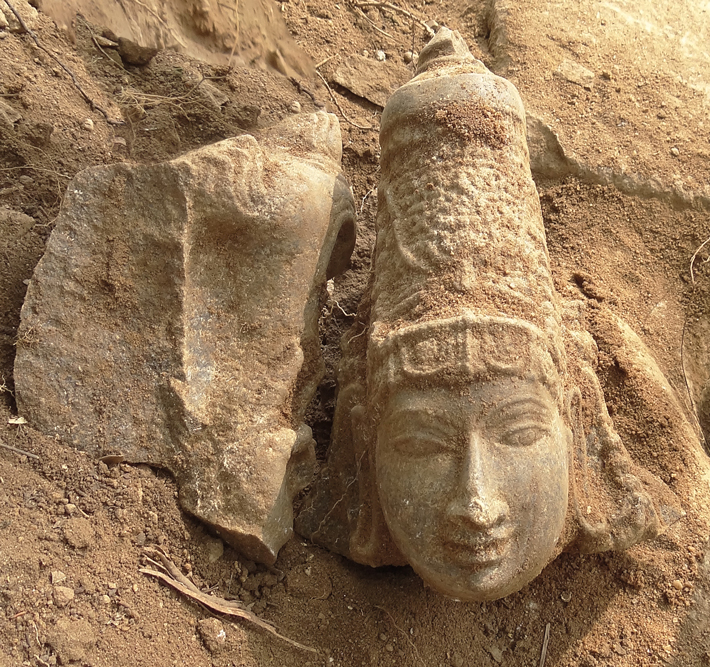 Srirangam Island, at the confluence of the Kaveri and Kollidam Rivers in southeastern India’s state of Tamil Nadu, is home to a 2,000-year-old temple complex, major parts of which are still in use today. However, much of the complex is hidden or damaged. Many older sections are buried under sediment as a result of centuries of flooding, and the complex was ransacked in the fourteenth century by the Muslim general Ulugh Khan. Recent excavations at the site, guided by geologists with knowledge of flood sediment layers, have begun to reveal what was presumed to have been lost. Researchers including geologist Mu Ramkumar of Periyar University have uncovered parts of the temple destroyed by Ulugh Khan and unearthed artifacts such as pendant lamps and statues of the deity Gopalakrishnan with his consorts. Using geophysical surveying techniques, they have also identified what they believe to be the tomb of religious scholar and teacher Sri Manavala Mamunigal, who restored the temple complex in the fifteenth century. The tomb has been left unexcavated for religious reasons.
Srirangam Island, at the confluence of the Kaveri and Kollidam Rivers in southeastern India’s state of Tamil Nadu, is home to a 2,000-year-old temple complex, major parts of which are still in use today. However, much of the complex is hidden or damaged. Many older sections are buried under sediment as a result of centuries of flooding, and the complex was ransacked in the fourteenth century by the Muslim general Ulugh Khan. Recent excavations at the site, guided by geologists with knowledge of flood sediment layers, have begun to reveal what was presumed to have been lost. Researchers including geologist Mu Ramkumar of Periyar University have uncovered parts of the temple destroyed by Ulugh Khan and unearthed artifacts such as pendant lamps and statues of the deity Gopalakrishnan with his consorts. Using geophysical surveying techniques, they have also identified what they believe to be the tomb of religious scholar and teacher Sri Manavala Mamunigal, who restored the temple complex in the fifteenth century. The tomb has been left unexcavated for religious reasons.
A Ride to Valhalla
By DANIEL WEISS
Friday, February 08, 2019
 When the Vikings who colonized Iceland more than 1,000 years ago interred their dead, they often included a perhaps surprising grave good—horses. Now, researchers have analyzed the scant amounts of DNA retrievable from 19 of these horses’ remains and determined that all but one was male. Why the Vikings were buried with male horses is unclear, although it may have had to do with an association between stallions and virility, according to zooarchaeologist Albína Hulda Pálsdóttir of the University of Oslo. However, she notes, horse burials were not reserved for men. In fact, around a third of those buried with horses were women.
When the Vikings who colonized Iceland more than 1,000 years ago interred their dead, they often included a perhaps surprising grave good—horses. Now, researchers have analyzed the scant amounts of DNA retrievable from 19 of these horses’ remains and determined that all but one was male. Why the Vikings were buried with male horses is unclear, although it may have had to do with an association between stallions and virility, according to zooarchaeologist Albína Hulda Pálsdóttir of the University of Oslo. However, she notes, horse burials were not reserved for men. In fact, around a third of those buried with horses were women.
Ahead of His Time
By MARLEY BROWN
Friday, February 08, 2019
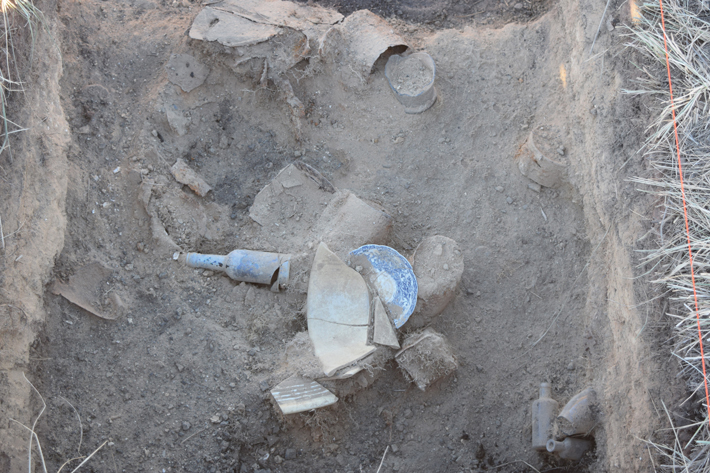
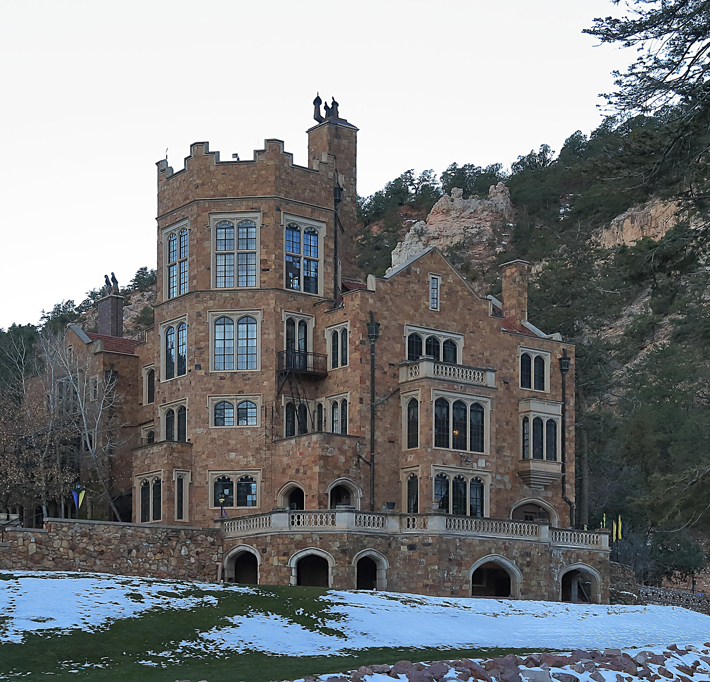 William Jackson Palmer was a Civil War hero, railroad magnate, and founder of Colorado Springs. He was also a connoisseur of the cutting-edge technology of his day, evidence of which has been found during an excavation of a late nineteenth- and early twentieth-century dumping ground on land that once belonged to his Colorado Springs estate, Glen Eyrie. Among the artifacts recovered from the site, on a creek bed roughly half a mile from Glen Eyrie’s castle, are fragments of early dry-cell batteries that Palmer used to power electric gates on the estate. “Palmer was on the forefront of technological advancement as well as self-sustainability,” says Sara Millward of Alpine Archaeological Consultants. Her colleague Mike Prouty adds that Palmer also ran a power plant on the property, designed reservoirs to supply running water to the house, and would likely have taken care to dispose of waste in a manner that would neither spoil the physical beauty of the estate nor interfere with his many engineering projects. Other objects found in the dump reveal Palmer’s taste for high living, including fine English ceramics, imported shellfish, and liquor bottles, whose contents the teetotaler Palmer presumably used to entertain his guests.
William Jackson Palmer was a Civil War hero, railroad magnate, and founder of Colorado Springs. He was also a connoisseur of the cutting-edge technology of his day, evidence of which has been found during an excavation of a late nineteenth- and early twentieth-century dumping ground on land that once belonged to his Colorado Springs estate, Glen Eyrie. Among the artifacts recovered from the site, on a creek bed roughly half a mile from Glen Eyrie’s castle, are fragments of early dry-cell batteries that Palmer used to power electric gates on the estate. “Palmer was on the forefront of technological advancement as well as self-sustainability,” says Sara Millward of Alpine Archaeological Consultants. Her colleague Mike Prouty adds that Palmer also ran a power plant on the property, designed reservoirs to supply running water to the house, and would likely have taken care to dispose of waste in a manner that would neither spoil the physical beauty of the estate nor interfere with his many engineering projects. Other objects found in the dump reveal Palmer’s taste for high living, including fine English ceramics, imported shellfish, and liquor bottles, whose contents the teetotaler Palmer presumably used to entertain his guests.
Celtic Trophy Heads
By JASON URBANUS
Friday, February 08, 2019
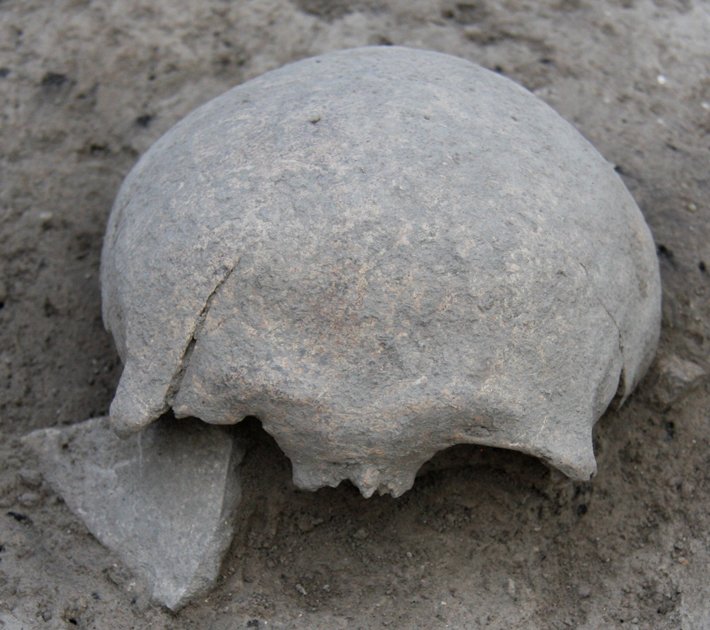 According to ancient Greco-Roman sources, Celtic warriors living in France more than 2,000 years ago practiced a gruesome ritual. They would remove the heads of their fallen enemies and proudly carry them home as trophies to be put on public display. Archaeological evidence of this practice has come in the form of human skulls discovered at several Celtic sites. An intriguing new study now confirms the sources’ assertion that the decapitated heads were embalmed. Chemical analysis of third-century B.C. skull fragments from the Celtic site of Le Cailar in southern France has detected the presence of conifer resins. Experts believe the pleasant-smelling resins may have been heated and mixed with plant oil before being applied to the heads as an embalming agent. “We don’t know the precise process, but this is the first time that we have scientific proof of embalming,” says archaeologist Réjane Roure of Paul Valéry University. The embalming mixture would have acted as an aromatic agent, and its antibacterial properties would have prevented decay and preserved the individual’s appearance, making the vanquished enemy recognizable for a long time.
According to ancient Greco-Roman sources, Celtic warriors living in France more than 2,000 years ago practiced a gruesome ritual. They would remove the heads of their fallen enemies and proudly carry them home as trophies to be put on public display. Archaeological evidence of this practice has come in the form of human skulls discovered at several Celtic sites. An intriguing new study now confirms the sources’ assertion that the decapitated heads were embalmed. Chemical analysis of third-century B.C. skull fragments from the Celtic site of Le Cailar in southern France has detected the presence of conifer resins. Experts believe the pleasant-smelling resins may have been heated and mixed with plant oil before being applied to the heads as an embalming agent. “We don’t know the precise process, but this is the first time that we have scientific proof of embalming,” says archaeologist Réjane Roure of Paul Valéry University. The embalming mixture would have acted as an aromatic agent, and its antibacterial properties would have prevented decay and preserved the individual’s appearance, making the vanquished enemy recognizable for a long time.
Honoring the Ancestors
By ERIC A. POWELL
Friday, February 08, 2019
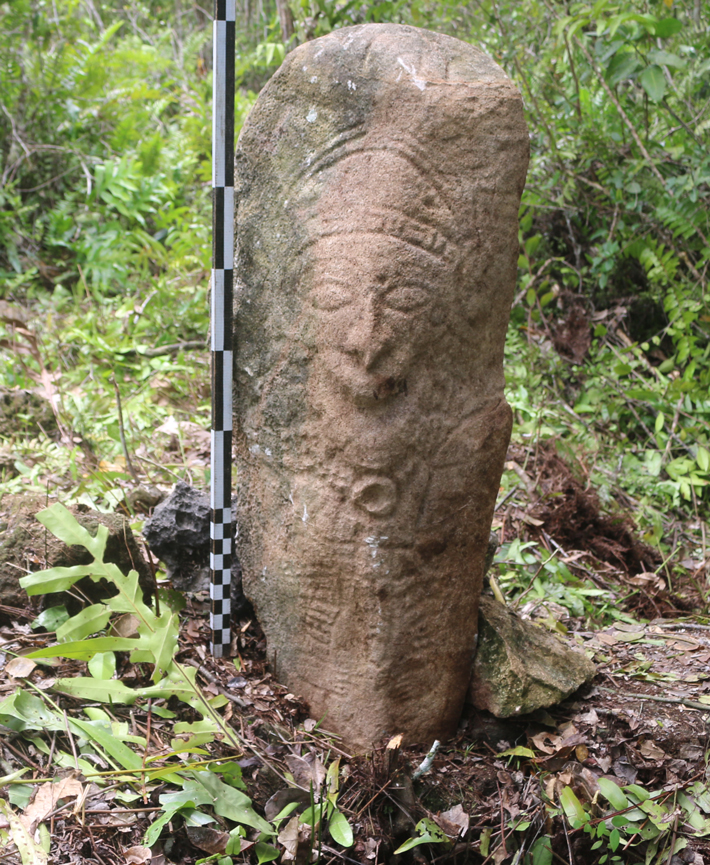 On the island of New Guinea, archaeologists have discovered several ornately decorated stone statues at a cemetery that may be more than 3,000 years old. Erlin Novita of the Papua Archaeological Center led a team that found the statues at Mount Srobu on the island’s north coast, in Indonesia’s Papua province. Here burials were hewn into limestone bedrock and covered with shell mounds by people of the megalithic cultures who likely made the statues. Most megalithic human depictions are simple, but the three-foot-tall statues unearthed by Novita’s team are complex. The bodies are posed in a crouching position, similar to statues known from Polynesia. Novita believes the statues represented important ancestors and were objects of worship. She notes that they are visually similar to the smoked mummies of Papuan chiefs that are traditionally preserved in a crouched position and that continue to be venerated in some parts of New Guinea to this day.
On the island of New Guinea, archaeologists have discovered several ornately decorated stone statues at a cemetery that may be more than 3,000 years old. Erlin Novita of the Papua Archaeological Center led a team that found the statues at Mount Srobu on the island’s north coast, in Indonesia’s Papua province. Here burials were hewn into limestone bedrock and covered with shell mounds by people of the megalithic cultures who likely made the statues. Most megalithic human depictions are simple, but the three-foot-tall statues unearthed by Novita’s team are complex. The bodies are posed in a crouching position, similar to statues known from Polynesia. Novita believes the statues represented important ancestors and were objects of worship. She notes that they are visually similar to the smoked mummies of Papuan chiefs that are traditionally preserved in a crouched position and that continue to be venerated in some parts of New Guinea to this day.
Advertisement
Advertisement
IN THIS ISSUE
From the Trenches
Fairfield's Rebirth in 3-D
Off the Grid
Reburial in Luxor
Mild Boars
Foreign Funeral Rites
The Magic Mineral
Die With Your Boots On
After the Rain
Ice Merchants
The Chicken People
Honoring the Ancestors
Ahead of His Time
Celtic Trophy Heads
A Ride to Valhalla
India's Temple Island
World Roundup
English food culture, Japanese weevils, the Sri Lankan spice trade, and surviving the Tibetan Plateau
Artifact
A lady’s circle of influence
Advertisement

Recent Issues
-
 May/June 2024
May/June 2024
-
 March/April 2024
March/April 2024
-
 January/February 2024
January/February 2024
-
 November/December 2023
November/December 2023
-
 September/October 2023
September/October 2023
-
 July/August 2023
July/August 2023
-
 May/June 2023
May/June 2023
-
 March/April 2023
March/April 2023
-
 January/February 2023
January/February 2023
-
 November/December 2022
November/December 2022
-
 September/October 2022
September/October 2022
-
 July/August 2022
July/August 2022
-
 May/June 2022
May/June 2022
-
 March/April 2022
March/April 2022
-
 January/February 2022
January/February 2022
-
 November/December 2021
November/December 2021
-
 September/October 2021
September/October 2021
-
 July/August 2021
July/August 2021
-
 May/June 2021
May/June 2021
-
 March/April 2021
March/April 2021
-
 January/February 2021
January/February 2021
-
 November/December 2020
November/December 2020
-
 September/October 2020
September/October 2020
-
 July/August 2020
July/August 2020
-
 May/June 2020
May/June 2020
-
 March/April 2020
March/April 2020
-
 January/February 2020
January/February 2020
-
 November/December 2019
November/December 2019
-
 September/October 2019
September/October 2019
-
 July/August 2019
July/August 2019
-
 May/June 2019
May/June 2019
-
 March/April 2019
March/April 2019
-
 January/February 2019
January/February 2019
-
 November/December 2018
November/December 2018
-
 September/October 2018
September/October 2018
-
 July/August 2018
July/August 2018
-
 May/June 2018
May/June 2018
-
 March/April 2018
March/April 2018
-
 January/February 2018
January/February 2018
-
 November/December 2017
November/December 2017
-
 September/October 2017
September/October 2017
-
 July/August 2017
July/August 2017
-
 May/June 2017
May/June 2017
-
 March/April 2017
March/April 2017
-
 January/February 2017
January/February 2017
-
 November/December 2016
November/December 2016
-
 September/October 2016
September/October 2016
-
 July/August 2016
July/August 2016
-
 May/June 2016
May/June 2016
-
 March/April 2016
March/April 2016
-
 January/February 2016
January/February 2016
-
 November/December 2015
November/December 2015
-
 September/October 2015
September/October 2015
-
 July/August 2015
July/August 2015
-
 May/June 2015
May/June 2015
-
 March/April 2015
March/April 2015
-
 January/February 2015
January/February 2015
-
 November/December 2014
November/December 2014
-
 September/October 2014
September/October 2014
-
 July/August 2014
July/August 2014
-
 May/June 2014
May/June 2014
-
 March/April 2014
March/April 2014
-
 January/February 2014
January/February 2014
-
 November/December 2013
November/December 2013
-
 September/October 2013
September/October 2013
-
 July/August 2013
July/August 2013
-
 May/June 2013
May/June 2013
-
 March/April 2013
March/April 2013
-
 January/February 2013
January/February 2013
-
 November/December 2012
November/December 2012
-
 September/October 2012
September/October 2012
-
 July/August 2012
July/August 2012
-
 May/June 2012
May/June 2012
-
 March/April 2012
March/April 2012
-
 January/February 2012
January/February 2012
-
 November/December 2011
November/December 2011
-
 September/October 2011
September/October 2011
-
 July/August 2011
July/August 2011
-
 May/June 2011
May/June 2011
-
 March/April 2011
March/April 2011
-
 January/February 2011
January/February 2011
Advertisement






